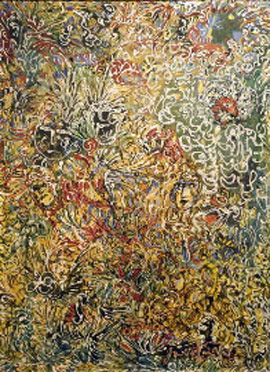11.27.24 — Under Pressure
Entering the holiday season means leaving the busy fall season behind. That makes it a good time to look back, and what better way than with a belated report on the fall art fairs? Here goes.
 For years I had promised myself to skip the New York art fairs. What can they add to an already busy gallery scene in New York?
For years I had promised myself to skip the New York art fairs. What can they add to an already busy gallery scene in New York?
What can they bring to the already enormous pressure of that first week after labor day, when openings run wild? If those same galleries find their sales dropping, and more and more experience dealers are calling it quits, the fairs bear their share of the blame here, too. So if I could cut back at last this past spring, could I pull it off again in September? Could a compulsive critic withstand the compulsion?
Maybe not, but I could look once again for the alternatives. That has its drawbacks, too. Who feels the costs more than the kind of galleries that exhibit at “alternative fairs”? If they are not on a budget, who is? Others may feel under pressure to splurge on booths at two fairs, the Armory Show and one more, closer to their buyers and their roots—and I work this together with a past report on the spring New York art fairs as a longer review and my latest upload. Still other exhibitors have no dealers or curators, only aspiring artists, and what ever too often is the pleasure for a critic in that?
I have no answer, but I still have my compulsions. And what could be more of an outsider than a fair with just one dealer, the gallery that hosts it, but calls itself an Armory Show affiliate anyway—Salon Zürcher for “11 Women of Spirit +” If “Spirit +” sounds more like a flavored vodka than a true shot in the arm, it allows Zürcher to reset its count of editions to Part One. It still leans to women in abstraction, a timely enough cause as well. It may be running thin, especially after a summer group show of a hundred women, but such is the pressure to exhibit art.
It does have charming enough local landscapes by Brigid Kennedy—and charming enough knitted portraits by Mary Tooley Parker. Marykate O’Neil groups her portraits of leisure, with a woman, perhaps the artist, sipping wine on a larger scale if passing judgment on them all. Abstraction, in turn, can be jazzy, as with Susan Cantrick, or brushier, as with Patricia Spergel, who adds an artist painting. Still, it does tend to run together. I remember more the work that lives between abstraction and figuration—flowers by Tracy Morgan and open skies by Sue Carlson with a yellow arc on top. I took it all in but was ready to move on.
Once Volta was a path-breaker, the fair with single-artist booths, the fair that makes you look and remember. Now even a room for Ukrainian artists packs them in, everything looks familiar, and wiser galleries exhibit elsewhere. A girl at night on a country road, in black-and-white photos by Sophie Zhai (with London’s Mandy Zhang) or portraits of blackness, in color photos by Joanne McFarland (with Accola Griefen)? Yeah, sure, although both stand out, and McFarland’s sitters could be role models, plastic dolls, or the baby girl next store. Maybe, though, the real problem lies with the perpetual art fairs, all of them? Can anything stand out any longer in all the madness?
You may not think so at Clio, borrowing the space of a Soho gallery, where artists choose themselves with predictable results. Look instead to what could be the true New York scene, its office buildings, and Spring/Break seems out to explore them all. The fair that sounds like a holiday at the beach has moved to Hudson Square north of Tribeca, and it fits right in. Small offices offers close-ups, but office culture shines best in common areas. The fair does have painting, from cheery abstraction to dark fantasies, and sculpture, like an eccentric chess set or large wood pieces in a forgotten game (and I do not name artists because Spring/Break often fails to identify them). Still, it seems only right that one office holds Post-It notes, and one artist leaves out his colored geometry as if taking over the bar—and I continue next time with Art on Paper and the Independent.
Read more, now in a feature-length article on this site.
They’re not knitted, they’re hooked rugs, a 19th century folk art.
Comment by Mary Tooley Parker — 12.8.24
Oops, quite right. Apologies and thanks.
Comment by JohnH — 12.9.24